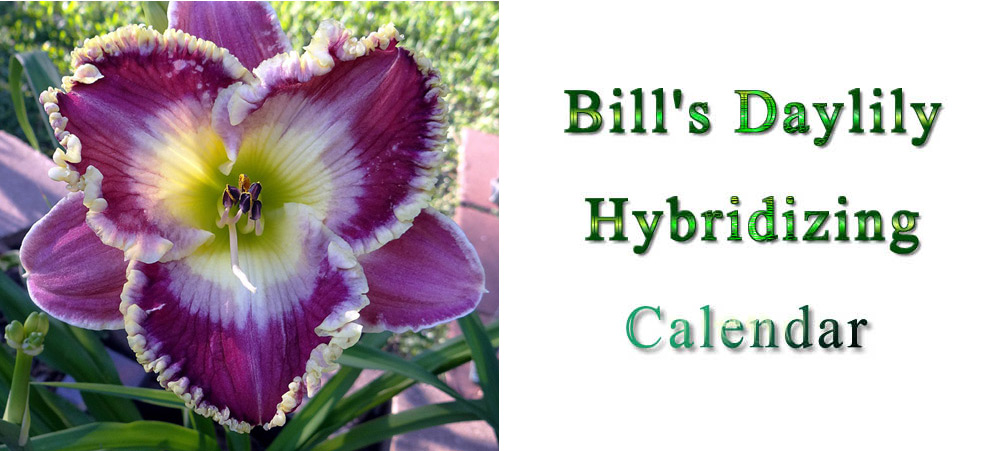I have always been a visual person. Of course there are numerous other factors but when selecting possible crosses the first thing I like to see are both bloom faces side by side to help me imagine possibilities. Over the years I have tried different ways to accomplish this. The image above illustrate how I currently accomplish this on my computer. The left 1/3 of the screen is a form from my Access database. The right 2/3 of the screen is Windows Explorer with the window sized to fit.
In the windows explorer pane you can see the folder list showing the folders for each color group (see December where I posted about setting up these folders). The pane to the right of the folders has thumbnails of the images in the selected folder. Then by simply clicking on a thumbnail, a larger image displays in the right pane. I am using Windows 7 and you may not be able to set up Explorer to look this way in earlier versions of Windows.
Starting with the first daylily in the stud spreadsheet, I ask myself if I want to use the daylily as a pod parent. In most cases I don't like setting pods on newly planted daylilies. There's no rule against it but it's my personal preference not to. I want to give it a full year to get established before I give it the added stress of producing seed in this hot humid climate. I also don't like to use daylilies that are not vigorous growers or have low bud counts as pod plants. I know of no proof but there's wide speculation that a seedling will inherit traits like plant vigor and bud count more from the pod parent than the pollen parent. There are also some daylilies that are difficult to impossible to set seed on which rules them out. If the daylily doesn't pass these tests I just skip on to the next daylily.
Once I have decided to use a cultivar as a pod parent, I select the cultivar in the database form to display its stats and then click on the ~~best pollen folder to display the best pollen parent thumbnails. I then click on possible pollen donor thumbnail images to display the larger image on the right of the screen. With both images displayed it is relatively easy to visually imagine what the resulting seedlings might look like. But finding a good visual match is only the beginning. Next I consider more specific traits that might make the cross undesirable.
When I find a visually promising cross, I minimize the windows explorer window to show Access full screen with three forms side-by-side. The first form is the pod parent I'm reviewing and the other two are for pollen parents (registered cultivars and seedling pollen parents). I keep seedlings separately from registered cultivars in my database. I call up the possible pollen donor in one of the forms on the right side (depending on whether it's registered or a seedling). Then I consider more specific traits that each have that might not work well together. Scape height for example. If both have shorter or taller than average scapes the resulting seedling will most likely have shorter or taller scapes similar to the parents. Poorly branched scapes on both cultivars will usually result in poorly branched seedlings. I also try to avoid matching two cultivars where both have poor bloom substance or where both sometimes have difficulty opening properly.
A stark example of what can happen when these types of considerations are ignored happend to me many years ago. I crossed two daylilies that both had tall scapes with primarily top branching (buds clustered together at the top of the scape). The result was a shock. Most scapes were 5 feet or taller and the blooms were all at the top of the scapes. It probably would have made a good novelty plant but the bloom color was similar to... well, let's just say mud.
In addition to making sure I don't match two daylilies with the same weakness I also often make an effort to use a cultivar that has a specific strength or trait that I want to bring to the pod cultivar. One example might be a pod plant that has a great bud count, a nice double edge, good form, and a vigorous grower but the eye is faded and not prominent. I might consider using pollen from a plant with a large dark eye hoping that the dark eye would combine with the other good traits from the pod plant. Another example is intentionally crossing a similar short scape cultivar with a very tall scape one and hope the result is something in the middle.
Once I have finished reviewing the ~~best pollen folder, if I haven't selected at least 8 pollen donors I move on to the daylilies in the other folders. Having folders organized by color allows me to go directly to the folders that contain the colors that make sense to cross with.
One thing I try not to do is cross two similar looking daylilies. That usually results in a seedling that looks very much like both parents. I'd much rather get something that is relatively unique (at least to me) than another look-alike. I do make an exception when each plant has strengths that offsets weaknesses in the other, hoping for an improvement over both parents but I try not to do this very often.
As I select the crosses I want to make, I enter them in my stud spreadsheet.

